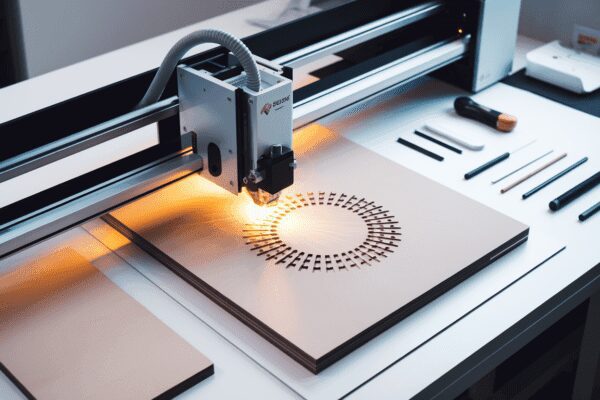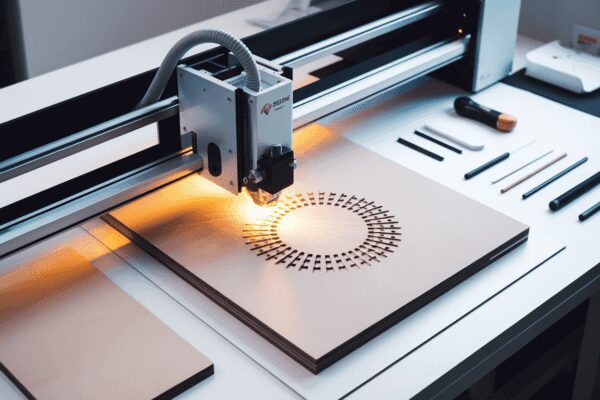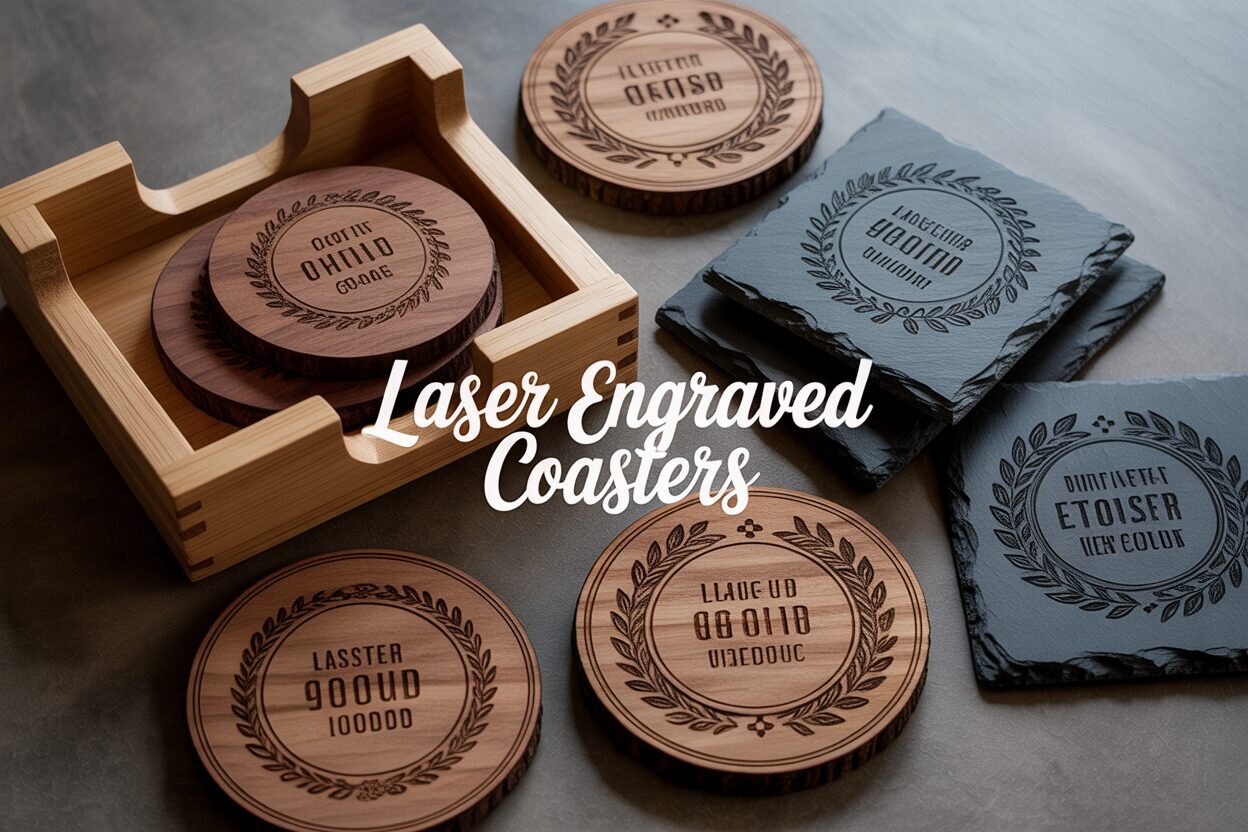A Beginner’s Guide to Crafting Laser Engraved Coasters
Estimated reading time: 6 minutes
Key Takeaways
- Material Matters: The choice between wood (acacia, bamboo, cork) and slate significantly impacts the final aesthetic, design possibilities, and the required laser settings. Wood offers a rustic, burned-in look, while slate provides a modern, high-contrast white-on-dark mark.
- Design File Quality is Crucial: For sharp, clean engravings, high-resolution raster images (300 DPI) or, preferably, vector files (SVG, DXF) are essential. Vector files are infinitely scalable without losing quality, making them ideal for text and line art.
- Finishing is Non-Negotiable: The final cleaning and sealing steps are what elevate a project to a professional level. Sealing protects coasters from moisture damage and enhances their appearance, with different sealants required for wood (polyurethane, lacquer, oil) and slate (mineral oil).
- Sourcing and Personalization: High-quality, laser-ready blanks can be found on marketplaces like Etsy and Amazon. You can easily find and customize pre-made designs with names or dates to create unique, personalized products, and even find matching coaster holder files.
Table of Contents
- Choosing Your Canvas: Wood vs. Slate
- Perfecting Your Coaster Designs and Files
- Engraving and Finishing for a Professional Look
- Conclusions
- Frequently Asked Questions
Personalized coasters are a fantastic way to add a custom touch to any home or to create a profitable product. This guide will walk you through the entire process, from selecting the right materials like wood and slate to the final sealing touches. We’ll explore design concepts and finishing techniques to help you create stunning, professional-quality laser engraved coasters every time.
Choosing Your Canvas: Wood vs. Slate
Choosing the right material is the first and most critical decision in your coaster-making journey. The canvas you select—be it the organic warmth of wood or the sleek elegance of slate—will define the final aesthetic, influence your design choices, and dictate your laser settings. Both materials produce stunning results, but they offer dramatically different creative paths.
Interested in more Coaster? Check out our Coaster laser file designs: Click here!
The classic choice, laser engraving wood coasters, brings a natural, rustic charm to any design. The laser doesn’t just mark the surface; it burns into the wood fibers, creating a recessed, tactile engraving with a distinct, smoky aroma. The type of wood you choose has a significant impact on the outcome.
- Acacia: Known for its deep, rich colors and dramatic grain patterns, acacia provides a beautiful and dynamic background. The laser produces a dark, consistent burn, creating strong contrast against the varied wood tones. Each acacia coaster is unique due to its natural grain, making it perfect for one-of-a-kind pieces.
- Bamboo: As a grass, bamboo has a very fine, uniform grain. This results in incredibly clean, precise engravings with minimal charring or “bleed.” The engraved areas typically turn a consistent caramel-brown color, offering a crisp, modern look. It’s a fantastic, eco-friendly option for detailed logos or intricate line art.
- Cork: This lightweight, porous material is incredibly easy to engrave. The laser creates a very dark, almost black mark with excellent contrast. However, its softness means you need to use very low power settings to avoid deep charring that can make the material brittle. Cork is highly absorbent, making it a functionally excellent coaster material.
Contrasting Canvases and Laser Settings
In stark contrast to wood, creating engraved slate coasters yields a sharp, modern, and exceptionally high-contrast result. The process here is entirely different. Instead of burning, the laser’s intense heat fractures, or ablates, the dark top surface of the stone, revealing the lighter gray layer beneath. This creates a permanent, bright white or light gray mark on a dark gray or black background. The engraving is nearly flush with the surface, offering a sleek, printed look that is perfect for highly detailed photographic engravings or crisp, bold text.
This fundamental difference in how the materials react to the laser necessitates very different settings. Wood engraving is a delicate balance of speed and power to achieve the desired level of darkness without causing excessive charring. For a 10W diode laser on acacia, you might start with a higher speed (e.g., 3000 mm/min) and moderate power (60-70%). Cork, being far more delicate, would require a much lower power setting, perhaps only 20-30%, at a similar speed. Conversely, slate is a robust material that requires more energy to mark. For the same laser, you would slow the speed down significantly (e.g., 1000 mm/min) and increase the power to 90-100% to ensure the laser has enough time and intensity to properly ablate the stone for a bright, clean mark.
Sourcing Quality Blanks for Your Projects
Finding consistent, high-quality blanks is essential for professional-looking results. For both wood and slate, online marketplaces like Amazon and Etsy, as well as specialized laser supply websites, are excellent sources. When sourcing wood coasters, look for blanks that are advertised as “laser-ready,” meaning they are sanded smooth and are of a consistent thickness to ensure your laser remains in focus across the entire project. For slate, decide if you prefer a rustic, hand-chipped edge or a modern, clean-sawn edge. It’s also wise to purchase slate blanks that are specifically sold for engraving, as these are typically coated to provide a more uniform dark finish for maximum contrast. Always order a few extra blanks than you need for testing your settings, a critical step we’ll cover later.
Perfecting Your Coaster Designs and Files
The quality of your final engraved coaster is determined long before the laser ever fires; it begins with the digital file. A crisp, clean design file is non-negotiable for a professional result. Artwork for laser engraving falls into two main categories: raster and vector. Raster images (like JPEGs, PNGs, or BMPs) are made of a grid of pixels. They are excellent for photographic engravings on slate, where gradients and shading can be reproduced. For these, always start with the highest resolution file possible, aiming for at least 300 DPI (dots per inch) at the final coaster size to avoid a blurry or pixelated outcome. Vector files (such as SVG, DXF, or AI) are the preferred format for most coaster designs. Instead of pixels, they are built from mathematical paths, lines, and curves. This means you can scale them to any size—from a tiny detail to a giant sign—with zero loss of quality. For the sharp lines, intricate patterns, and clean text common in coaster art, vectors are superior.
Sourcing and Customizing Your Artwork
Fortunately, you don’t need to be a graphic designer to find incredible artwork. The internet is filled with resources for high-quality laser cut coaster designs. Marketplaces like Etsy, Creative Fabrica, and Design Bundles are treasure troves of SVG and DXF files created specifically for laser users. When browsing, look for designs that match the aesthetic of your chosen material. Bold, geometric patterns look stunning on slate, while intricate mandalas or rustic nature scenes are a perfect match for wood. Many designers sell themed bundles, giving you a set of four or six cohesive designs for a single price. Always check the license agreement to ensure you can use the file for personal projects or, if you plan to sell your coasters, that a commercial license is available.
The true magic of laser crafting lies in personalization. Most design files are easily editable in your laser’s software, such as LightBurn or LaserGRBL, or in free vector editing programs like Inkscape. Customizing a pre-made design with a family name, a wedding date, or a special quote transforms a simple object into a cherished keepsake. When adding text, choose a font that is thick enough to be clearly legible once engraved, as very thin lines can get lost in the grain of the wood. Use the alignment tools in your software to perfectly center your custom text within the design. For a truly complete and professional-looking gift, consider taking your project a step further. Many file marketplaces also offer a matching coaster holder laser file. These are typically simple designs that you can cut from 3mm or 5mm plywood and assemble to create a custom holder, turning your set of coasters into a beautifully packaged and highly desirable product.
Engraving and Finishing for a Professional Look
With your material selected and your design file perfected, you’re ready for the most exciting step: bringing your creation to life with the laser. Secure your coaster blank to the laser bed using hold-down pins or strong tape to prevent it from shifting during the engraving process. Use your laser software’s “frame” or “trace” function to preview the engraving area, ensuring your design is perfectly centered on the coaster. Once you’ve confirmed your power and speed settings are correct for your material, start the job and watch the laser work its magic. After the engraving is complete, the journey to a professional-grade product is not over; the finishing process is what separates a good coaster from a great one.
The first step post-engraving is a thorough cleaning. Wood engraving produces a smoky, sticky residue that can dull the final appearance. To clean it, gently wipe the surface with a cloth lightly dampened with denatured alcohol or a simple solution of water and mild soap. Work quickly and carefully to lift the residue without smudging it into the un-engraved wood grain. A soft-bristled brush can help clear debris from deeply engraved areas. For slate, the process is simpler. A wipe with a damp cloth is usually all that’s needed to remove the fine stone dust created during ablation, instantly revealing the crisp, bright contrast of your design.
How to Seal Laser Engraved Coasters for a Lasting Finish
Sealing is the most critical final step. An unsealed coaster, especially one made of wood, will be quickly ruined by condensation from a cold drink, leading to water stains and warping. The goal is to create a durable, water-resistant barrier that protects the material and your engraving. The right sealant depends entirely on your canvas.
For wood coasters, you have several excellent options:
- Polyurethane or Spar Urethane: These offer the highest level of protection, creating a tough, waterproof plastic-like film over the wood. Spar urethane has the added benefit of UV inhibitors. Apply 2-3 very thin coats using a spray can or a wipe-on formula, allowing each coat to dry completely. For an ultra-smooth finish, lightly sand with very fine-grit sandpaper (400+) between coats. This is the best choice for coasters that will see heavy use.
- Spray Lacquer or Acrylic Sealer: This is the fastest and easiest method. A few light coats from a spray can builds up a protective layer that is highly water-resistant. Choose a clear satin or matte finish to preserve the wood’s natural look.
- Food-Safe Finishes (Mineral Oil, Tung Oil): If you prefer a more natural, less “plastic” feel, a penetrating oil finish is a great choice. These oils soak into the wood fibers, enhancing the grain and providing water resistance rather than a surface film. To apply, wipe on a liberal coat, let it soak in for 15-20 minutes, then buff off all excess with a clean, dry cloth. While beautiful, this finish is less durable and may require reapplication every few months.
For slate coasters, the goal of sealing is less about waterproofing and more about enhancing contrast and preventing fingerprints. The most popular method by far is to use simple mineral oil. Apply a small amount of food-safe mineral oil to a cloth and wipe it over the entire surface. The oil will darken the slate’s natural gray/black color, making the light-colored engraving pop with incredible visual contrast. After letting it sit for a minute, buff the coaster with a clean cloth until it feels dry to the touch. This leaves a beautiful, rich finish that can be easily refreshed as needed.
Conclusions
You now have the knowledge to create beautiful and durable laser engraved coasters from both wood and slate. By choosing the right materials, preparing your files correctly, and applying a proper sealant, you can produce high-quality items for personal use or for sale. Experiment with different designs and techniques to develop your unique style and enjoy this rewarding laser-cutting project.
Frequently Asked Questions
Q: What is the best coaster material for a beginner?
A: Both wood and slate are great for beginners, but they offer different experiences. Cork is one of the easiest materials to engrave due to its softness, requiring very low laser power. Slate is also straightforward as it produces high contrast easily, but it requires higher power and slower speeds. For wood, bamboo is an excellent choice for beginners because its uniform grain leads to very clean, predictable results.
Q: Do I absolutely have to seal my coasters?
A: Yes, sealing is a critical step for creating a durable and long-lasting product. For wood coasters, sealing is essential to protect against water stains, warping, and mold from drink condensation. For slate coasters, sealing with mineral oil dramatically enhances the contrast of the engraving and helps prevent fingerprints, giving it a much more finished, professional look.
Q: What’s the difference between a vector and a raster file?
A: A raster file (like a JPEG or PNG) is made of a grid of pixels. It’s great for photos but can become blurry or pixelated if scaled up. A vector file (like an SVG or DXF) is made of mathematical paths. It can be scaled to any size—tiny or huge—with absolutely no loss of quality, making it the superior choice for the sharp lines, text, and logos commonly used in coaster designs.
Q: Where can I find designs if I’m not a graphic designer?
A: You don’t need to be a designer to find great artwork. Online marketplaces like Etsy, Creative Fabrica, and Design Bundles are excellent resources for affordable, high-quality laser-ready files (usually in SVG or DXF format). You can often buy bundles of cohesive designs, and many files are easily customizable with names or dates in your laser software.


Subscribe to Our Newsletter
And enjoy FREE Download Files, SALE Alerts and Inspiring TIPS


A Beginner’s Guide to Crafting Engraved Slate Coasters
A Comprehensive Guide to Crafting Laser Engraved Slate Coasters
A Guide to Crafting a Personalized Charcuterie Board
Charcuterie Board Engraving File – Wine & Grapes 3D Illusion…
$4.00Original price was: $4.00.$3.00Current price is: $3.00.(25% off)
Valentine Love Captions: 6 Charcuterie Board Engraving Files…
$8.00Original price was: $8.00.$5.60Current price is: $5.60.(30% off)
Bee and Honey Jar Charcuterie Board Engraving File | PNG Download #007…
$4.00Original price was: $4.00.$3.20Current price is: $3.20.(20% off)
Bee & Hive Charcuterie Board Engraving – HQ PNG Download…
$4.00Original price was: $4.00.$2.80Current price is: $2.80.(30% off)